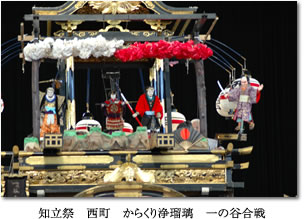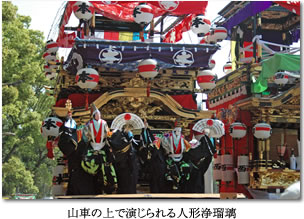The parade floats used in the Chiryu Festival are unusual even in the Karakuri heartland of Aichi Prefecture. Three floats feature Bunraku puppet theater performances, one of these being of the Jōruri variety. During the Edo period, four separate parade floats were in use, with the upper half of each float used for Karakuri doll performances and the lower half used for Jōruri performances.
These performances are held as part of the Chiryu Shrine Festival, in Chiryu-shi, Aichi Prefecture. The 2012 main festival took place on May 5th. Performance locations and the festival program are given below.
Nishimachi - Jōruri performance of Ichi no Tani no Kassen on upper level of float (revival of Heiji-Gassen Karakuri performance in 2010).
Nakashinmachi - performance of Kamakura Sandaiki on the front platform of the parade float.
Yamamachi - performance of Date Musume Koi no Higanoko on the front platform of the parade float.
Honmachi - performance of Keisei Awa no Naruto on the front platform of the parade float.
Takaramachi - performance of Tsubosaka Kannon Reikenki on the front platform of the parade float.


In the Chita area, a number of parade float festivals feature Jōruri performances:
Chita City - Okada Shimeisha Shrine Festival
Sato-gumi group: Jōruri performance on the upper level of the float, Akugenta Heiji Gassen (The play is an Ito-Karakuri performance featuring five dolls, including Taira no Kiyomori and Ushiwakamaru.).
Three-person marionette performances on the float's lower level: “San-basō” and “San-morime”
Kaminoma, Mihama-chō, Chita-gun - Kaminoma Shrine Festival
Ochishimagumi group - Karakuri Jōruri performance, Tamura Kawakami Kame Tsurizao/Minamoto no Yoshitune Hinode-sha/Genji Eboshi no Dan.
Yonshima-gumi group - Karakuri Jōruri performance, Momiji-gari Imose O-Kagami/Sanzoku Taiji no Dan.
Tokoname City, Sakai - Sakai Festival, Matsuo Shrine Festival
Karakuri Jōruri performance of Gunjutsu Homare Shirahata Oni'ichi Hōgenkan no Dan.
Minamichita-chō
Utsumi - Narihira Hachiman Yama no Dan (last performed in 1955).
Yamami - Kotori Maruyume no Sukedachi (last peformed in 1955).
Handa City, Tokoname City
Front platform, three-person Sanbasō - a unique form of puppeteering which differs from Bunraku. The puppet is displayed in front of a curtain, while three puppeteers operate the puppet from behind the curtain, controlling the head and torso, hands, and feet, respectively.
“Mikawa is not only the area where Jōruri theater originated, but also the birthplace of the Jōruri Princess (Jōruru Hime) tale. A verbal legend also exists. People's interest in this legend may have led to the creation of the theater piece which bears the same name. Yoshida Bunraku exists to this day in Toyohashi City. Mikawa has a long-standing reputation for its vibrant local theater scene. Theatrical performances were originally more popular than Karakuri doll performances. In Chiri City, an inn town near Owari and located on the Tōkaidō route, Karakuri parade float culture from Owari combined with the Mikawa passion for theater performance. This led to the birth of Karakuri Jōruri, Karakuri doll theater performances performed on top of festival parade floats. It appears that this tradition was subsequently transmitted to Chita City.” Yasuda Bunkichi. 1994. Aichi Esōshi Hiite, Mawashite, Mata Hiite, It'sA (イッツエイ), Issue 4, p. 33
